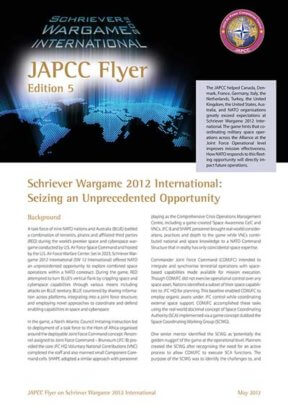Background
A task force of nine NATO nations and Australia (BLUE) battled a combination of terrorists, pirates and affiliated third parties (RED) during the world’s premier space and cyberspace wargame conducted by U.S. Air Force Space Command and hosted by the U.S. Air Force Warfare Center. Set in 2023, Schriever Wargame 2012 International (SW 12 International) offered NATO an unprecedented opportunity to explore combined space operations within a NATO construct. During the game, RED attempted to turn BLUE’s vertical flank by crippling space and cyberspace capabilities through various means including attacks on BLUE territory. BLUE countered by sharing information across platforms; integrating into a joint force structure; and employing novel approaches to coordinate and defend enabling capabilities in space and cyberspace.
In the game, a North Atlantic Council Initiating Instruction led to deployment of a task force to the Horn of Africa organised around the deployable Joint Force Command concept. Personnel assigned to Joint Force Command – Brunssum (JFC-B) provided the core JFC HQ. Voluntary National Contributions (VNC) completed the staff and also manned small Component Command cells. SHAPE adopted a similar approach with personnel playing as the Comprehensive Crisis Operations Management Centre, including a game-created ‘Space Awareness Cell’, and VNCs. JFC-B and SHAPE personnel brought real-world considerations, practices and depth to the game while VNCs contributed national and space knowledge to a NATO Command Structure that in reality has only coincidental space expertise.
Commander Joint Force Command (COMJFC) intended to integrate and synchronise terrestrial operations with space-based capabilities made available for mission execution. Though COMJFC did not exercise operational control over any space asset, Nations identified a subset of their space capabilities to JFC HQ for planning. This baseline enabled COMJFC to employ organic assets under JFC control while coordinating external space support. COMJFC accomplished these tasks using the real-world doctrinal concept of Space Coordinating Authority (SCA) implemented via a game concept dubbed the Space Coordinating Working Group (SCWG).
One senior mentor identified the SCWG as ‘potentially the golden nugget’ of the game at the operational level. Planners created the SCWG after recognising the need for an active process to allow COMJFC to execute SCA functions. The purpose of the SCWG was to identify the challenges to, and opportunities for, space support to JFC operations conducted in order to achieve the desired end-state. The SCWG resulted in a product termed the Joint Prioritised Space Effects Lists (JPSEL) which COMJFC sent to SHAPE and Nations to enable them to generate the required capabilities.
Findings
Drawing conclusions from a wargame is risky, but several findings ring true.
- Orchestrating space capabilities to form an element of the scheme of manoeuvre via an authority such as SCA requires active planning between SHAPE, the JFC, and the various capability providers
- Tailoring Space Support to theatre operations is a shared and continuous partnership between the theatre and the various providers, implying the need for a common operational language
- The use of space warrants evaluation by planners during Centre of Gravity analysis and may result in the need for personnel from the strategic to the tactical level to anticipate protective measures in advance
- The NATO Command Structure has only coincidental space expertise but various NATO member states already have space experts in their forces
Future Considerations
The assessments of SW 12 International from Air Force Space Command, ACT, and individual nations will document many findings in addition to those above. Also worthy of further examination are questions such as:
Who is ‘interoperable’?
Interoperability includes aspects such as machine-to-machine interaction, procedural standardisation, training and education. In the game, players assumed one-for-one replacement value as RED targeted individual capabilities. This assumption requires validation.
Who coordinates space capabilities at the national level?
Civil, military, commercial and other governmental organisations may all own some subset of their individual national space capacity. In each nation, a lead coordinator of these various subsets could improve total national efficiency and provide a single point of contact during multinational operations.
Why not Space and Cyber Components?
The game highlighted the requirement to preserve freedom of action in space and cyberspace as supporting efforts to traditional operations. COMJFC normally tasks components to secure freedom of action in their operating domains.
Is the Area of Operations (AOO) concept outdated?
During game planning, one JFC member predicted the decreasing relevance of the AOO concept. Game observations support that assertion. For example, despite a regional focus, RED targeted the intersection of space and cyberspace outside of the AOO creating global impacts. Participants noted that an adversary may attack the ground portion of a space asset beyond the realm of COMJFC, directly impacting the conflict.
Conclusion
One cannot overstate the importance and success of SW 12 International. Given the critical roles now performed by space and cyberspace in operations, the game has the potential to be one of the key recent events in the history of the Alliance. SW 12 International suggests the coordination of military space operations across the Alliance at the Joint Force Operational level significantly improves mission effectiveness, increases resilience, and decreases risk. But wargame success cannot be confused with reality and no one should mistakenly believe that today’s Alliance could do what was done in the game. Before success is realised at the operational level the most difficult aspects of combined space operations such as information sharing, updating organisational responsibilities, implementing standardised processes, and creating a cadre of trained and certified personnel, first require NATO to establish the necessary underlying architecture.











